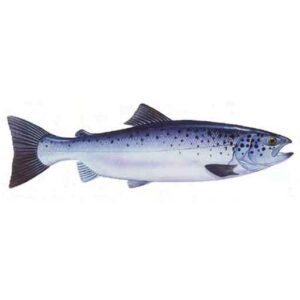Introduction
For busy individuals and families, forgetting to thaw fish for dinner can be a common occurrence. But don’t worry, there’s a solution that will save you from last-minute grocery runs and dinner dilemmas: cooking fish from frozen. In this comprehensive guide, we’ll explore the techniques and tips for successfully cooking frozen fish, whether you have cod, salmon, or other varieties on hand.
Table of Contents
Can You Cook Frozen Fish?
The answer is a resounding yes! Cooking fish from frozen has become a game-changer for many home cooks. By following a few simple steps, you can have a delicious and nutritious meal ready in no time. Gone are the days of defrosting fish and waiting for it to reach room temperature. With this technique, you can cook fish straight from the freezer, saving you time and ensuring that you always have a backup plan for dinner.
The Basic Method: Cooking Fish Without Breading
Let’s start with the basic method for cooking fish from frozen. This technique works well for fish fillets like cod or salmon. Here’s what you’ll need:
Ingredients:
- Frozen fish fillets (cod, salmon, etc.)
- Olive oil or vegetable oil
- Salt, pepper, and/or other seasonings or sauce
Instructions:
- Preheat your oven to 450°F.
- Remove the frozen fish from its packaging and rinse it under cold running water to remove any ice crystals.
- Place the fish fillets in a single layer on a baking sheet.
- Brush the fillets lightly with oil on all sides.
- Bake the fish for 4-5 minutes.
- Remove the baking sheet from the oven and add your desired seasonings or sauce.
- Continue baking the fish until it is hot and flaky in the center, usually for an additional 8-12 minutes. Thicker portions may need to be flipped over halfway through cooking and may require a few extra minutes to cook through.
By following these simple steps, you’ll have perfectly cooked fish that retains its moisture and flavor, even when cooked from frozen.
Making Breaded Fish From Frozen
If you prefer a crispy and flavorful crust on your fish, you can easily adapt the basic method to make breaded fish from frozen. While the previous method is great for a quick and simple meal, adding a breadcrumb coating takes it to the next level. Here’s how to do it:
Ingredients:
- Frozen fish fillets (cod, salmon, etc.)
- 2 tsp. olive oil or vegetable oil
- Salt, pepper, and/or other seasonings or sauce
- 2 tbsp. milk
- 2 tbsp. Dijon mustard
- 1/2 cup panko bread crumbs
- 1 tsp. olive oil
- 1/8 tsp. salt
- 1/8 tsp. black pepper
- 1/4 tsp. garlic powder
Instructions:
- Preheat your oven to 450°F.
- Remove the frozen fish from its packaging and rinse it under cold running water to remove any ice crystals.
- Lightly oil the cod portions and place them on a heavy-duty baking sheet.
- Bake the fish at 450°F until it’s nearly cooked through, about 10 minutes.
- While the fish is baking, mix together the milk and Dijon mustard. Set it aside.
- In a separate bowl, combine the panko bread crumbs, olive oil, salt, black pepper, and garlic powder. Stir until all the crumbs are moistened.
- Toast the bread crumbs in a skillet on the stove over medium heat or on a sheet pan in the 450°F oven for 3-5 minutes, until they turn golden brown. Be sure to watch them carefully and stir once to prevent burning.
- Remove the fish from the oven and brush the tops of the fillets lightly with the Dijon-milk mixture.
- Sprinkle the fillets with the toasted breadcrumbs.
- Return the fish to the oven and continue baking until the internal temperature reaches 145°F and the fish is flaky in the middle.
- Serve and enjoy your delicious homemade breaded fish!
Cooking From Frozen: Tips and Tricks
Now that you know the basic and breaded methods for cooking fish from frozen, let’s explore some additional tips and tricks to ensure optimal results:
1. Choose the Right Fish
Not all fish are suitable for cooking from frozen. Stick to thick fillets like cod or salmon, as they hold up well during the cooking process. Delicate fish varieties may not fare as well and can become mushy when cooked from frozen.
2. Adjust Cooking Times
Cooking times may vary depending on the thickness of the fish fillets. Thicker portions will require longer cooking times, while thinner ones will cook more quickly. It’s important to monitor the fish closely and use an instant-read thermometer to ensure it reaches the proper internal temperature.
3. Seasoning Options
Experiment with different seasonings and sauces to elevate the flavor of your frozen fish. From simple salt and pepper to tangy lemon juice or zesty marinades, the possibilities are endless.
4. Use High Heat
Preheating your oven to a high temperature, such as 450°F, ensures that the frozen fish cooks quickly and evenly. This helps to preserve its texture and moisture, resulting in a delicious meal.
5. Flip Thicker Portions
For thicker fish fillets, consider flipping them halfway through the cooking process to ensure even cooking throughout. This will help prevent the exterior from becoming overly browned while the center remains undercooked.
6. Test for Doneness
To determine if your fish is cooked to perfection, use an instant-read thermometer. Insert it into the thickest part of the fish, and it should register 145°F. Additionally, the fish should be opaque and easily flake apart when gently prodded with a fork.
7. Serve Immediately
Frozen fish is best enjoyed fresh out of the oven. Serve it immediately to preserve its texture and temperature. Pair it with your favorite sides, such as roasted vegetables or a refreshing salad, for a complete and satisfying meal.
Other Cooking From Frozen Guides
Cooking fish from frozen is just one of the many ways you can prepare meals quickly and conveniently. If you’re interested in exploring more cooking from frozen techniques, here are some helpful guides from our site:
- Chicken Breasts from Frozen
- How to Cook Frozen Chicken Wings
- Air Fryer Frozen Shrimp
- Sausages From Frozen Recipe
- How to Cook Frozen Lobster Tails
These guides will provide you with additional inspiration and techniques for preparing delicious meals using frozen ingredients.
FAQs About Cook Fish From Frozen
Is it safe to cook fish directly from frozen?
Yes, it’s generally safe to cook fish directly from frozen, but it may require longer cooking times to ensure it reaches a safe internal temperature. However, thawing first often leads to better texture and even cooking.
What are the best methods for thawing frozen fish?
Refrigerator: The safest and most recommended method. Place the fish in a sealed bag or container on the bottom shelf of the refrigerator overnight for thick cuts or 6-8 hours for thinner ones.
Cold water bath: Submerge the sealed fish in a bowl of cold water, changing the water every 30 minutes. This is faster than the refrigerator method, but ensure the water doesn’t exceed 40°F to avoid bacterial growth.
Microwave (thaw setting only): This is the quickest method but requires careful monitoring. Use the defrost setting only and cook the fish immediately after thawing.
What are some tips for preventing frozen fish from becoming dry?
Don’t overcook it! Use a meat thermometer to monitor internal temperature and remove from heat just before reaching 145°F.
Opt for moist cooking methods like poaching, baking in parchment paper, or using a sauce.
Add moisture during cooking: Brush with oil, add broth or wine to the pan, or use a flavorful marinade.
Can I refreeze thawed fish?
It’s generally not recommended to refreeze thawed fish as it can affect texture and quality. However, if you thaw the fish in the refrigerator and only use part of it, you can refreeze the remaining portion for later use.
Conclusion
Cooking fish from frozen is a game-changing technique that saves you time and ensures you always have a backup plan for dinner. Whether you prefer the basic method or the breaded version, you can enjoy perfectly cooked fish straight from the freezer. With the right techniques and tips, you’ll have a delicious and nutritious meal on the table in no time. So, the next time you forget to thaw your fish, don’t panic—just follow our guide and enjoy a hassle-free dinner!















